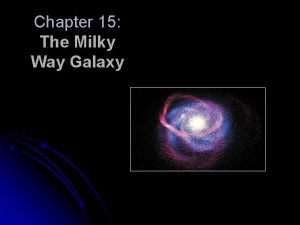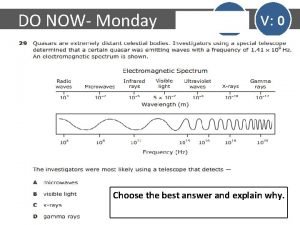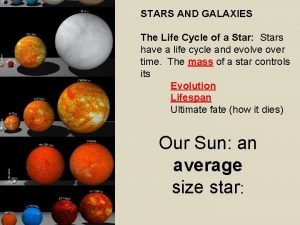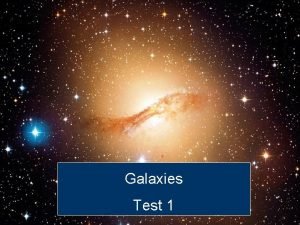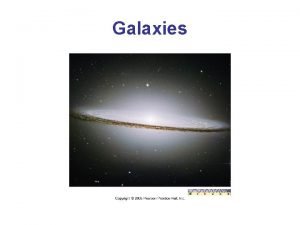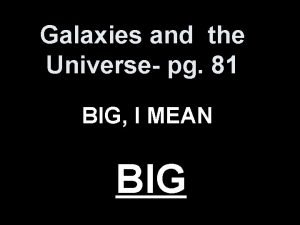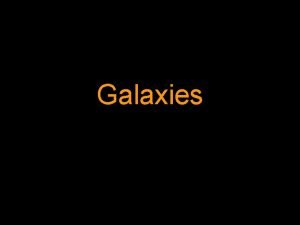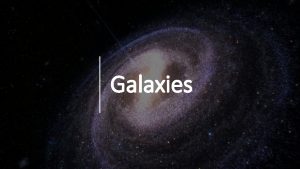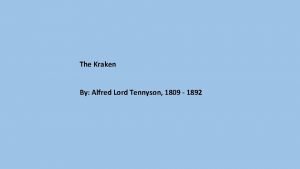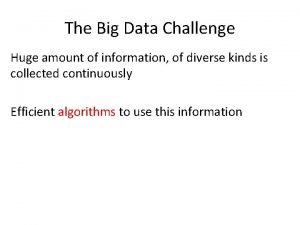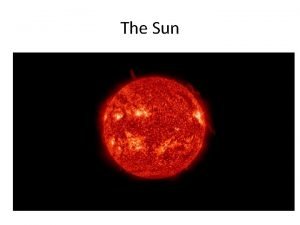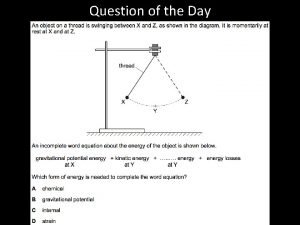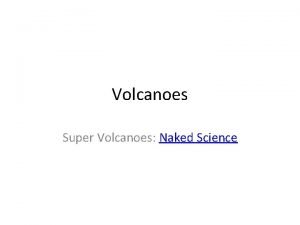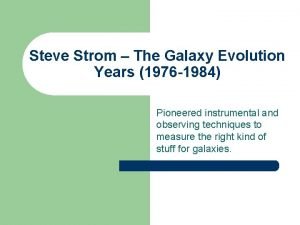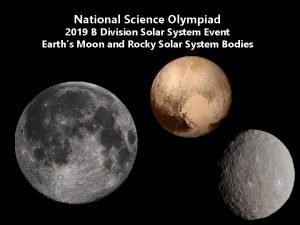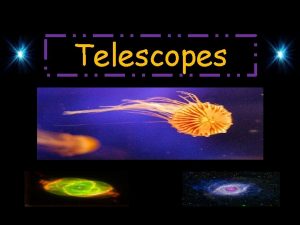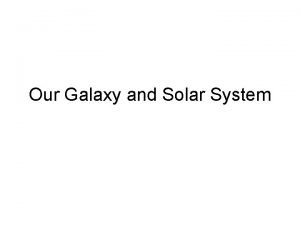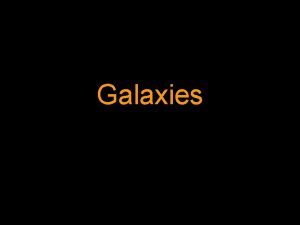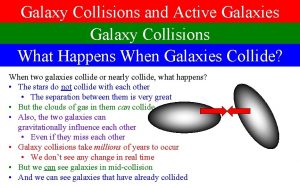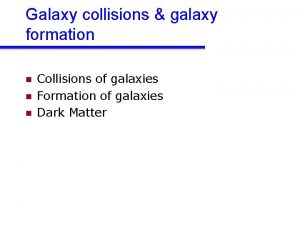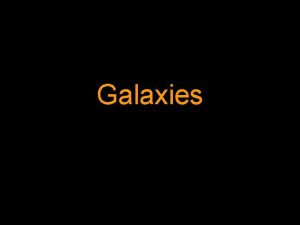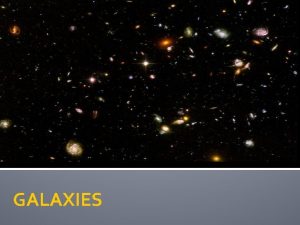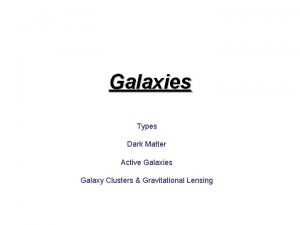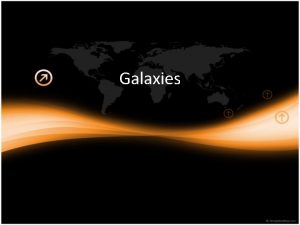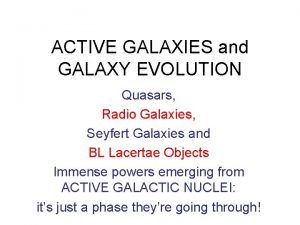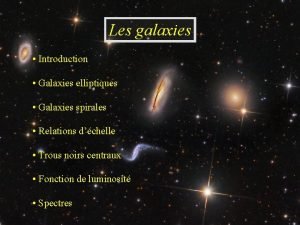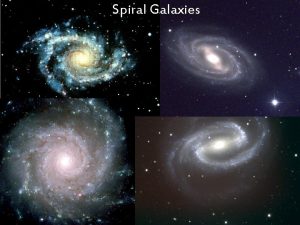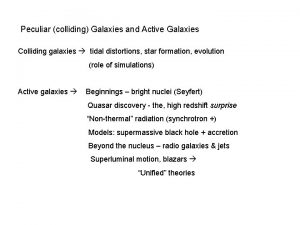Galaxies Galaxies l A galaxy is a huge













































- Slides: 45

Galaxies

Galaxies l. A galaxy is a huge region of space that contains hundreds of billions of stars, planets, glowing nebulae, dust, empty space, and possibly black holes. l Galaxies began when large clouds of gas and dust started to shrink as a result of their gravity.

Galaxies l Galaxies are held together by gravity. l According to Hubble’s Law, galaxies are moving away from one another. l 100 billion or so exist in the universe.

Shapes of Galaxies l Hubble categorized these shapes or basic schemes of galaxies: 1. 2. 3. Spiral Elliptical (nearly circular) Irregular

Spiral Galaxies l Arms tightly wound around galaxy, like a pinwheel l A group of objects in center (stars and possibly a black hole) l Surrounded by a halo and an invisible cloud of matter.

Spiral Galaxies l Rotating – which forms arms l May lose arms and become elliptical l Examples: Milky Way and Andromeda Galaxies

Spiral Galaxies

Elliptical Galaxies l Can be round, oval, flattened or spherical l Resembles the nucleus of a spiral galaxy without the arms l Very little gas or dust

Elliptical Galaxies l Mostly older stars l Collect into globular clusters l Examples: Maffei 1, M 32

Elliptical Galaxies

Irregular Galaxies l Neither spiral or elliptical l Disk, but no spiral arms l Caused by the formation of new stars in the galaxy or by the pull of neighboring gravitational fields

Irregular Galaxies l In some irregular galaxies one can see individual stars, nebulae, and clusters l Mixture of old and new stars l Large amounts of gas and dust l Examples: Large and Small Magellanic Clouds

Irregular Galaxies

Barred Spiral Galaxies l Spirals with bright bar of gas down center.

Lenticular Galaxies l l Consists of bulge and disk with little or no new star formation. Example: Spindle Galaxy

Parts of a Galaxy l The galaxy is made up of two visible components: 1. Disk 2. Bulge

Parts of a Galaxy – The Disk l Contains clouds of gas and dust called nebulae l In a spiral galaxy, most stars are in the disk l Open Cluster (Galactic Clusters) are younger, asymmetric groups of stars.

Parts of a Galaxy – The Disk l An example of a galactic cluster is Pleiades (M 45)

Parts of a Galaxy - Bulge l A large squashed sphere surrounding the galaxy’s center l Contains older stars l Not very much gas or dust l One fifth of the total light comes from the bulge

Parts of a Galaxy - Bulge l The bulge can be used to determine the age of the galaxy l Above and around the bulge are globular clusters – hundreds of thousands of stars bound in a tight spherical swarm

Parts of a Galaxy - Bulge l An example of a globular cluster is M 13 (Hercules Globular Cluster)

The Milky Way Galaxy l Over 100 billion stars and possibly a black hole in the center. l Has star clusters, planets, glowing nebulae, dust and empty space. l Older stars and globular cluster near the center

The Milky Way Galaxy l Younger stars and galactic clusters in disk l One hundred thousand (100, 000) light years in diameter. Ten thousand (10, 000) light years thick l Our solar system is located on the Orion Arm – 30, 000 light years from the center.

The Milky Way Galaxy l Part of the Local Group of super clusters (Andromeda is also part of this group) l Astronomers use radio and infrared telescopes to “see” the center of the galaxy l We can’t actually “see” the center of the galaxy because of dust and gas!

The Milky Way Galaxy l The Milky Way is getting larger because it is “eating” the Large Magellanic Cloud. Its stars are being added to the Milky Way. l The Milky Way is falling toward the Andromeda Galaxy and both are feeling the tug of the great Virgo Cluster, which is 50 million light years away.

Virgo Cluster

The Milky Way Galaxy


Andromeda Galaxy (M 31) l Can only be seen by astronomers in the Northern hemisphere l 2. 2 million light years away l Can see without a telescope, appears as a faint fuzzy patch l About the same size as the Milky Way l Two times more massive than the Milky Way

Andromeda Galaxy

Large and Small Magellanic Clouds l Can only be seen by astronomers in the Southern Hemisphere l The two closest galaxies to the Milky Way (Less than 200, 000 light years away) l Visible to the naked eye

Large and Small Magellanic Clouds l Relatively small and irregular in shape l Only five percent of the mass of the Milky Way l Large Magellanic is being “eaten” by the Milky Way

Large Magellanic Clouds

Small Magellanic Clouds

Messier Catalog System l Charles Messier was looking for comets. l Made a list of star clusters, galaxies and nebula so that he would not mistake them for comets. l Listed 110 objects, including 32 galaxies by 1780. l Andromeda – M 31










 Spiral galaxy elliptical galaxy irregular galaxy
Spiral galaxy elliptical galaxy irregular galaxy Tipus de galaxies
Tipus de galaxies Era of galaxies
Era of galaxies Galaxies lesson plan
Galaxies lesson plan Brainpop galaxies quiz answers
Brainpop galaxies quiz answers Life cycle of galaxies
Life cycle of galaxies Type of galaxy
Type of galaxy Milky way galaxy shape
Milky way galaxy shape 4 types of galaxies
4 types of galaxies Elliptical galaxies facts
Elliptical galaxies facts Evolution of galaxies
Evolution of galaxies Chapter 30 galaxies and the universe
Chapter 30 galaxies and the universe How are active galaxies classified?
How are active galaxies classified? Th eirregulars
Th eirregulars Universe pg
Universe pg Types of galaxies
Types of galaxies Electromagnetic star
Electromagnetic star Large monuments created by huge stones
Large monuments created by huge stones I remember the newspaper dying like huge moths
I remember the newspaper dying like huge moths Midwest iconography
Midwest iconography Largest galaxy
Largest galaxy Erm performance tuning
Erm performance tuning Central conflict of fahrenheit 451
Central conflict of fahrenheit 451 The kraken by alfred lord tennyson
The kraken by alfred lord tennyson Which features of the sun look like huge cloudlike arches
Which features of the sun look like huge cloudlike arches Brown algae characteristics
Brown algae characteristics A huge amount of information
A huge amount of information Bighugelabs motivator
Bighugelabs motivator Wht is the sun
Wht is the sun Brilliantbiome
Brilliantbiome The sound of approaching grain teams
The sound of approaching grain teams A moving cart slows slightly as it rolls toward a spring
A moving cart slows slightly as it rolls toward a spring Masses of ocean water that flow from one place to another
Masses of ocean water that flow from one place to another What is a mountain
What is a mountain Images of weather systems on television come from
Images of weather systems on television come from Which is a huge luminous ball
Which is a huge luminous ball Exploding comfortably down on the cliffs
Exploding comfortably down on the cliffs Digital strategy case study
Digital strategy case study Huge fibroids
Huge fibroids Slow and steady wins the race find the predicate
Slow and steady wins the race find the predicate Our earth is surrounded by a huge blanket of
Our earth is surrounded by a huge blanket of Huge surge artinya
Huge surge artinya Meaning of grass
Meaning of grass Article galaxy scholar
Article galaxy scholar Steve's galaxy (legacy)
Steve's galaxy (legacy) Solar system science olympiad
Solar system science olympiad



